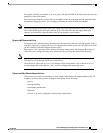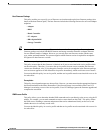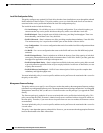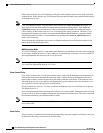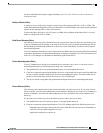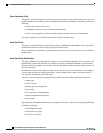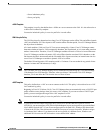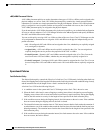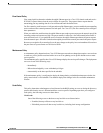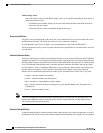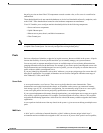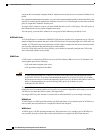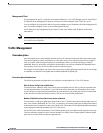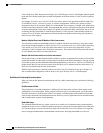
• Server inheritance policy
• Server pool policy
vHBA Template
This template is a policy that defines how a vHBA on a server connects to the SAN. It is also referred to as
a vHBA SAN connectivity template.
You need to include this policy in a service profile for it to take effect.
VM Lifecycle Policy
The VM lifecycle policy determines how long Cisco UCS Manager retains offline VMs and offline dynamic
vNICs in its database. If a VM or dynamic vNIC remains offline after that period, Cisco UCS Manager deletes
the object from its database.
All virtual machines (VMs) on Cisco UCS servers are managed by vCenter. Cisco UCS Manager cannot
determine whether an inactive VM is temporarily shutdown, has been deleted, or is in some other state that
renders it inaccessible. Therefore, Cisco UCS Manager considers all inactive VMs to be in an offline state.
Cisco UCS Manager considers a dynamic vNIC to be offline when the associated VM is shutdown, or the
link between the fabric interconnect and the I/O module fails. On rare occasions, an internal error can also
cause Cisco UCS Manager to consider a dynamic vNIC to be offline.
The default VM and dynamic vNIC retention period is 15 minutes. You can set that for any period of time
between 1 minute and 7200 minutes (or 5 days).
The VMs that Cisco UCS Manager displays are for information and monitoring only. You cannot manage
VMs through Cisco UCS Manager. Therefore, when you delete a VM from the Cisco UCS Manager
database, you do not delete the VM from the server or from vCenter.
Note
vNIC Template
This policy defines how a vNIC on a server connects to the LAN. This policy is also referred to as a vNIC
LAN connectivity policy.
Beginning in Cisco UCS, Release 2.0(2), Cisco UCS Manager does not automatically create a VM-FEX port
profile with the correct settings when you create a vNIC template. If you want to create a VM-FEX port
profile, you must configure the target of the vNIC template as a VM.
You need to include this policy in a service profile for it to take effect.
If your server has two Emulex or QLogic NICs (Cisco UCS CNA M71KR-E or Cisco UCS CNA
M71KR-Q), you must configure vNIC policies for both adapters in your service profile to get a user-defined
MAC address for both NICs. If you do not configure policies for both NICs, Windows still detects both
of them in the PCI bus. Then because the second eth is not part of your service profile, Windows assigns
it a hardware MAC address. If you then move the service profile to a different server, Windows sees
additional NICs because one NIC did not have a user-defined MAC address.
Note
Cisco UCS Manager GUI Configuration Guide, Release 2.0
OL-25712-04 27
Server Architecture and Connectivity



